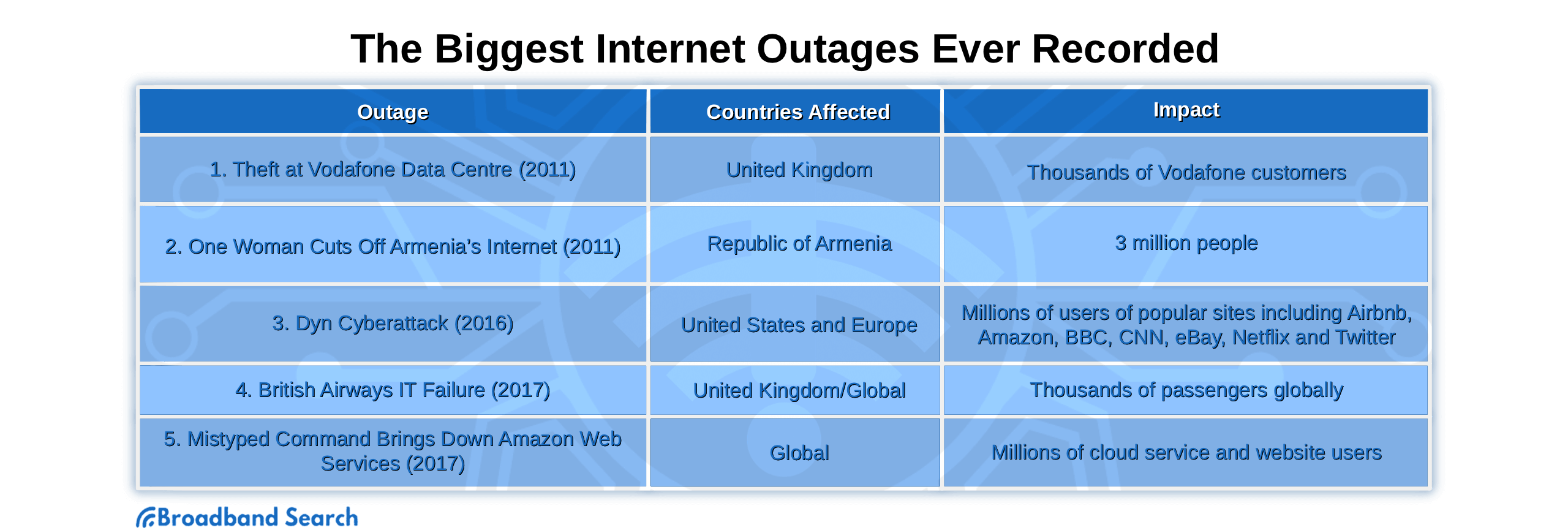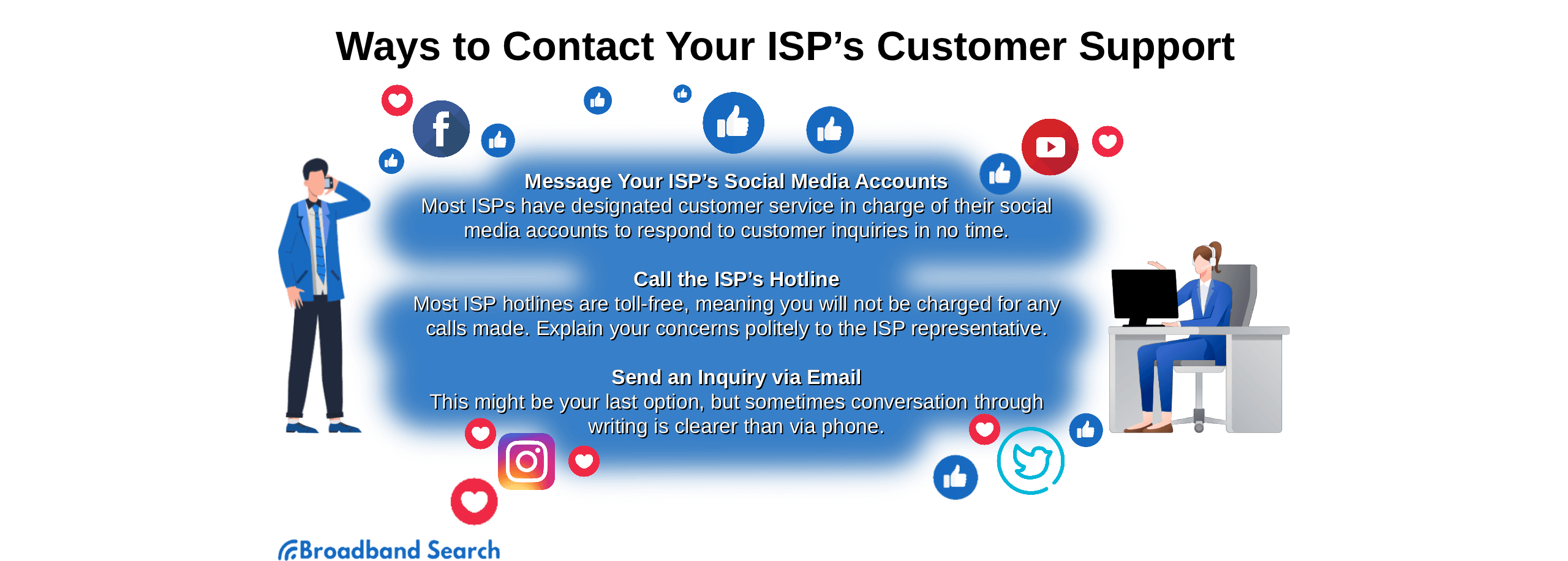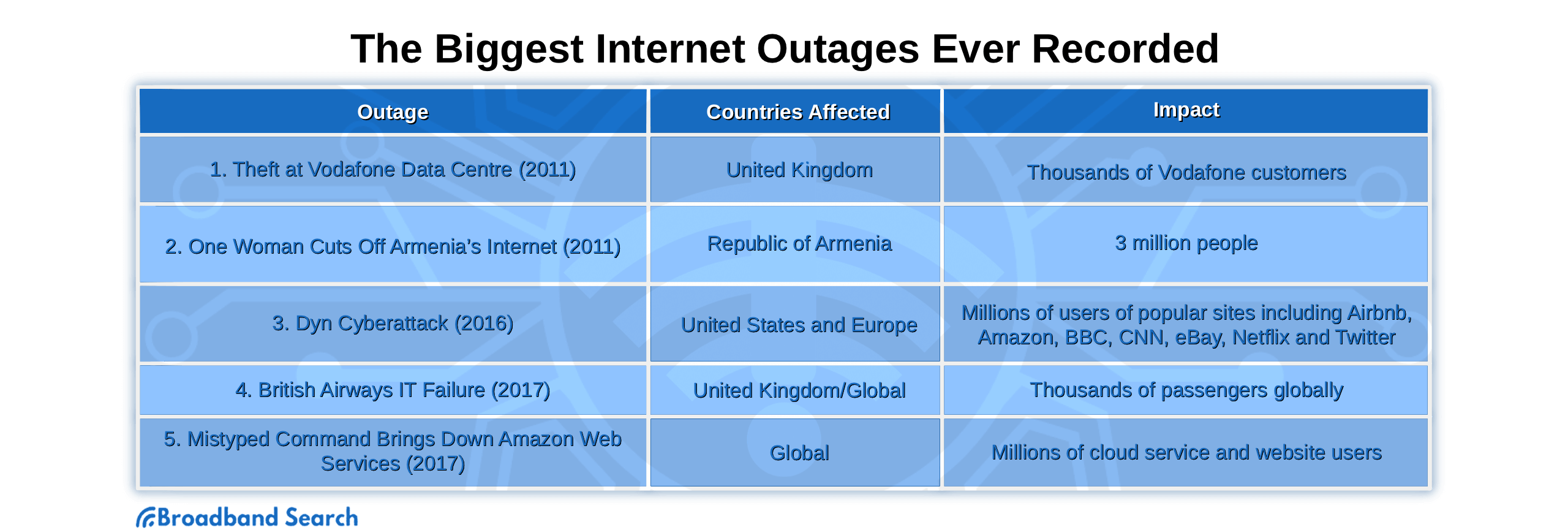An internet outage is a full or partial loss of internet service in your home or across your area. Because so much of modern life depends on a stable connection—from messaging family to getting work done—an outage can be incredibly frustrating. Real-time outage maps can help ease some of that stress by keeping you updated on what's happening.
BroadbandSearch highlights the best tools and resources for tracking real-time internet outages, helping users quickly see whether connectivity issues are local or widespread.
What Causes Internet Outages?
For every internet outage, there will be a cause. Finding this cause will lead to the solution and, therefore, can help us either fix the problem ourselves or wait for our ISP to fix it. Below are some of the common causes of internet outages:
Power Outage in Your Area
You can’t have an internet connection without power. If there is a power outage in your home or a power outage that affects your internet provider’s upstream connections, you will not be able to get an internet connection. If there is a power outage in your home, you can try to find out what is causing it and turn the power back on again, which will also bring your connection back.
Equipment Failure
It’s essential for the equipment that provides you with an internet connection to be updated and working correctly. This can include your router, modem, computer, cables, and anything else.
You should do software updates regularly if there are any, and hardware updates if you think that the hardware you’re using is outdated. This will ensure that whatever you’re using can handle the connection you’re trying to get and shouldn’t run into issues due to poor performance.
In addition to the software and hardware being up to date, you need to ensure that all of your equipment is compatible. If you’re using cables or devices that can’t communicate properly, it can cause you to have slow internet or no internet connection.
Lastly, you need to ensure that there are no damages to any equipment (especially the cables). If any cables within your home or those connecting you to your ISP are damaged, you will likely be unable to get a connection.
Network Congestion
With more and more people using the internet daily, you’ve likely experienced (or will experience) network congestion. When more people are using the internet at the same time, the lines become “congested” with traffic, making connections very slow or causing the internet to stop working altogether. ISPs should have a solution to this - increasing capacity - but it can take time. They may have systems to prevent congestion from stopping everyone’s internet altogether and slowing everyone’s connection down during peak hours.
Extreme Weather
Extreme weather can affect internet connections, but it affects some types of internet more than others. Storms, hurricanes, heavy snowfall, etc., can cause damage to equipment like cables and prevent satellite dishes from making a solid connection with satellites. This then causes internet outages which can either be fixed by waiting for the bad weather to pass or when the damaged equipment is fixed.
Human Error
Yup, we’re only human, meaning we make mistakes - even as professionals. Sometimes, there may be an issue with the way that the internet has been installed in your home or somewhere along the way to your home, causing an internet outage. Of course, technicians need to have the skills to avoid these errors and avoid damaging the equipment when installing it, but mistakes are not unheard of.
Cyberattack
Cyberattacks can be rare, but they can cause major internet outages when they do happen. Most cybercriminals target big internet service providers because they can make the most significant impact and might get a chance to get money out of the attack. If this happens, your ISP might notify you of the attack to help you understand what’s happening.

Best Real-Time Maps for Internet Outages
The quickest way to determine whether or not there’s an internet outage is to check if there are announcements on your ISP’s website or social media pages. However, if there is no update, a number of websites offer information about which areas are having problems with their internet connection.
ThousandEyes (by Cisco)
ThousandEyes offers a global visualization of internet health over the last 24 hours. It’s useful for getting a quick, at-a-glance overview of worldwide stability.
Features:
- Allows you to zoom into maps for region-specific outage insights.
- Identifies which servers or networks may be causing disruptions.
Limitations:
It doesn't provide deep detail on the causes of an outage or what specific ISPs are doing to resolve the issue.
SolarWinds Pingdom
Pingdom is great for tracking live outages worldwide, with a focus on disruptions occurring within the last hour.
Features:
- Provides details about the most common error messages people are receiving, which can help you match them to what you’re seeing.
- Includes insights into the browsers and devices affected during outages.
Limitations:
You can’t zoom into the map, meaning the information remains quite general and isn't ideal for pinpointing local issues.
DownDetector
DownDetector tracks internet outages for different ISPs, companies, and applications, showing outage trends over the last 24 hours.
Features:
- Allows you to search for outages affecting specific services and provides insight into when the disruptions started.
- Shows you where the most reported problems are coming from (e.g., website vs. mobile app).
- Offers a heat map to help you identify localized issues and has a mobile app to keep you updated on the go.
Limitations:
The platform relies on user reports to provide information. If you're one of the first to experience an issue, it may not show up right away.
Comparison Table: Internet Outage Map Tools
| Feature | ThousandEyes (Cisco) | SolarWinds Pingdom | DownDetector |
|---|---|---|---|
| Coverage Window | Last 24 hours (global view) | Last hour (live focus) | Last 24 hours (service-specific) |
| Visualization | Global map with zoom | Global map (no zoom) | Heat maps + outage trends |
| Detail Provided | App servers & networks overview | Error messages, browsers, devices | Outage start time, affected platforms |
| Strengths | At-a-glance global internet health | Matches error messages with your issues | Localized reports, mobile app, service search |
| Limitations | Limited ISP-level cause details | General data, no zoom feature | Relies on user reports (may lag) |
Call Your Internet Service Provider
If any of the outage maps you’ve tried didn’t help you identify any outages, or if you simply couldn’t figure out what was being shown on the maps, you can always reach out to your ISP’s customer service team. They will be able to clarify what’s going on and will likely also be able to give you more detail about the situation and what they’re doing to fix the problem.

Conclusion: Track Internet Outages in Real Time
Internet outage maps are one of the fastest ways to skip unnecessary troubleshooting and confirm if a broader service issue is happening in your area. They help you see whether the problem is with your home connection or with the site or service you’re trying to reach. By checking outage maps first, you’ll always stay one step ahead and avoid wasted time.
Before you do anything drastic, like resetting all your equipment, make sure to check a trusted outage map. And for everything else internet-related, visit BroadbandSearch for the latest guides, tools, and insights.
Key Takeaways
- Real-time visibility: Outage maps show live disruptions across ISPs, mobile networks, and cloud providers.
- Data sources: The best tools combine crowdsourced reports with network monitoring for accuracy.
- Different tools, different strengths: Options like Downdetector, ThousandEyes, and others serve both consumers and businesses.
- Practical use: These maps help users confirm if issues are local or widespread, and IT teams rely on them for faster troubleshooting.
- Historical insights: Some maps track patterns and trends to help prepare for future outages.
- Business value: Quick insights reduce the impact of downtime and support better decision-making.
FAQ
How do I test intermittent network connection?
To test intermittent network connection, you can go through several troubleshooting processes, but this will take a lot of time and effort. One of the easier things you can do is utilize network monitoring software, which will give you insight into the problems you’re experiencing and what might be causing them.
What test should you use for connectivity problems?
One of the tests that you can use if you’re experiencing connectivity problems is an internet speed test. Some of the options you have will give you a lot of information about how your internet is operating, the latency you have, etc., which can help you identify problems with your connection.
What are the five network diagnostic utilities?
Five network diagnostic utilities include ping, tracert, ipconfig, netstat, and nsloookup.
What router is best to avoid an internet outage?
Different routers will be suitable for different connections. If you keep getting internet outages due to your router, it’s a good idea to check with your ISP on what router they recommend for the connection. If you’re still getting outages, there are a lot of top-of-the-range routers that might help you to avoid the problem (such as gaming routers).
What do the lights mean on a router during an internet outage?
Most routers have a light on them that is dedicated to an internet connection. When you have an internet connection, this light will be solid. If there is an internet outage, this light might change to a different color (e.g., red) or flash or turn off completely.
How do I check if the internet is down right now?
First, visit your ISP’s website to see if they’ve posted any outage alerts. If nothing is listed, try third-party sites like DownDetector, ThousandEyes, or SolarWinds Pingdom, which track real-time outages and can confirm if others in your area are experiencing issues.

